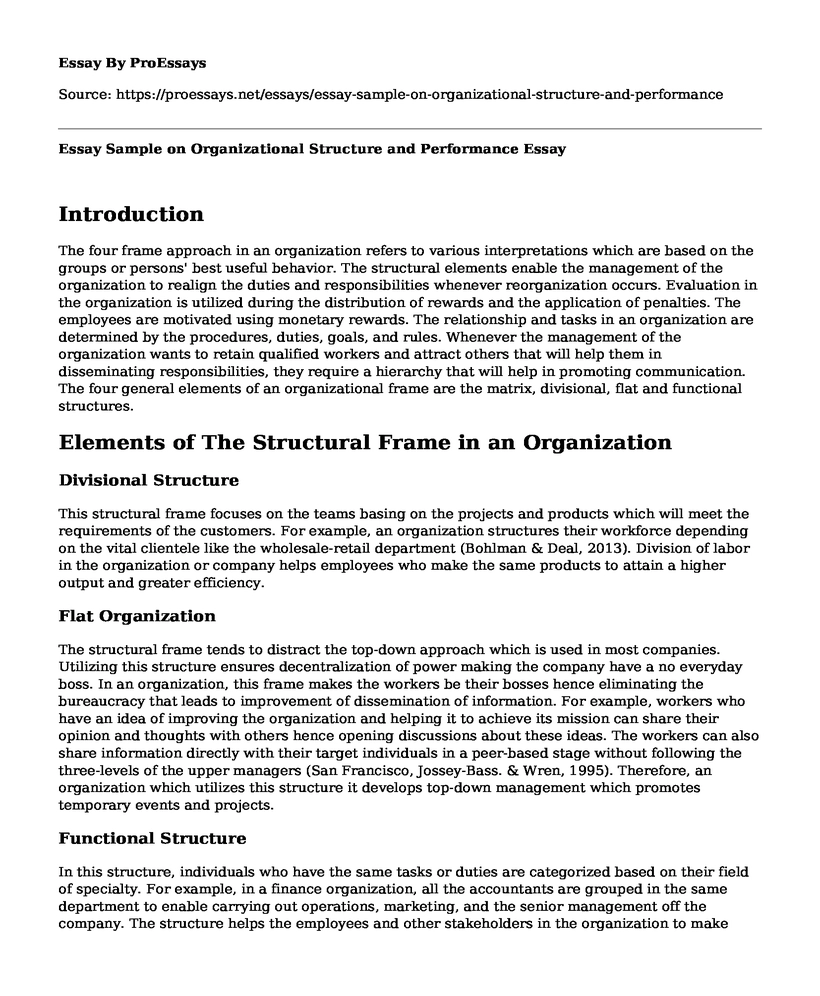Introduction
The four frame approach in an organization refers to various interpretations which are based on the groups or persons' best useful behavior. The structural elements enable the management of the organization to realign the duties and responsibilities whenever reorganization occurs. Evaluation in the organization is utilized during the distribution of rewards and the application of penalties. The employees are motivated using monetary rewards. The relationship and tasks in an organization are determined by the procedures, duties, goals, and rules. Whenever the management of the organization wants to retain qualified workers and attract others that will help them in disseminating responsibilities, they require a hierarchy that will help in promoting communication. The four general elements of an organizational frame are the matrix, divisional, flat and functional structures.
Elements of The Structural Frame in an Organization
Divisional Structure
This structural frame focuses on the teams basing on the projects and products which will meet the requirements of the customers. For example, an organization structures their workforce depending on the vital clientele like the wholesale-retail department (Bohlman & Deal, 2013). Division of labor in the organization or company helps employees who make the same products to attain a higher output and greater efficiency.
Flat Organization
The structural frame tends to distract the top-down approach which is used in most companies. Utilizing this structure ensures decentralization of power making the company have a no everyday boss. In an organization, this frame makes the workers be their bosses hence eliminating the bureaucracy that leads to improvement of dissemination of information. For example, workers who have an idea of improving the organization and helping it to achieve its mission can share their opinion and thoughts with others hence opening discussions about these ideas. The workers can also share information directly with their target individuals in a peer-based stage without following the three-levels of the upper managers (San Francisco, Jossey-Bass. & Wren, 1995). Therefore, an organization which utilizes this structure it develops top-down management which promotes temporary events and projects.
Functional Structure
In this structure, individuals who have the same tasks or duties are categorized based on their field of specialty. For example, in a finance organization, all the accountants are grouped in the same department to enable carrying out operations, marketing, and the senior management off the company. The structure helps the employees and other stakeholders in the organization to make appropriate decisions since they easily share information with each other (De Cremer, van Dick & Murnighan, 2011). The employees can learn through communication from each other as they have the same knowledge, skills, and interests in the conduction of their task.
Matrix Structure Combining the Divisional and Functional Structure
This structure is more complicated than the other frameworks since it utilizes the divisional and functional models. The model groups the workers into functional departments that deals with specialization and later divides them into divisional products and projects. These individuals under this structure are allocated more autonomy thus being expected to have more accountability on their tasks. By doing this, the organization can improve its productivity fostering the creativity and innovations of the employees. The framework also helps the managers to make decisions that will help them in solving problems which hinder the organization from achieving their set goals and objectives (Bohlman & Deal, 2013). Therefore, the structure is appropriate for a large organization since it requires lots of efforts and planning.
References
Bohlman, L. & Deal, T. (2013). Reframing organizations: Artistry, choice and leadership, 5th Ed. Retrieved from https://www.scirp.org/(S(351jmbntvnsjt1aadkposzje))/reference/ReferencesPapers.aspx?ReferenceID=1871421
De Cremer, D., van Dick, R., & Murnighan, J. K. (2011). Social psychology and organizations. New York, NY: Routledge. Retrieved from https://www.scholars.northwestern.edu/en/publications/social-psychology-and-organizations
San Francisco: Jossey-Bass. Wren, T.J. (Ed.). (1995). The leader's companion: Insights on leadership through the ages. New York, NY: The Free Press. Retrieved from https://scholarship.richmond.edu/cgi/viewcontent.cgi?referer=https://www.google.com/&httpsredir=1&article=1019&context=bookshelf
Cite this page
Essay Sample on Organizational Structure and Performance. (2022, Nov 17). Retrieved from https://proessays.net/essays/essay-sample-on-organizational-structure-and-performance
If you are the original author of this essay and no longer wish to have it published on the ProEssays website, please click below to request its removal:
- Marketing Mix Strategies Essay
- Research Paper on Marketing Strategy for Samsung Galaxy
- Essay Sample on Board Members' Responsibility and Liability in Non-Profit Orgs
- Essay Example on Tambrands' Global Expansion: Leveraging P&G's Infrastructure
- Essay on Grow Your Business With a Service-Based App: Benefits of Health Care & Well-Being Services
- Essay on Communication Evolved: Exploring the Impact of Technology on Advertisements
- Essay Example on Culture vs. Lifestyle: How Are They Different?







